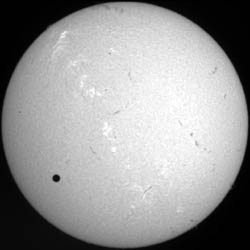2004 Archives
Transit of Venus, June 8, 2004
View archives of programs webcast live from the National Observatory of Athens–Penteli Station. The first program watches Venus enter the disk of the sun, and the second sees Venus leave the sun several hours later. During both programs, a stronomers describe the fascinating history of earlier transits, what we've learned from them, and how transits across faraway stars are helping us identify and learn about planets outside of our solar system.

• View video of Venus through Lick Observatory's 36″ refractor [RealMedia stream]
• See cool TRACE images of the transit [NASA website]
• Incredible SOHO sun images from the transit [SOHO website]
• High-resolution stills of the transit :
Notes:
There are two sets of images here. One set was taken through a special filter that lets through only the red light given off by hydrogen gas (called "hydrogen-alpha"). This lets you see details on the Sun's surface invisible in the other white-light photos. The optical filtering system causes the images of the hydrogen-alpha photos to be flipped relative to the white light images.
The names of the images tell you the date and time the image was taken. For instance, a file named 2004-06-08T05-13-53.774.jpg was taken on June 8th, 2004 at 5:13:53.774 Universal Time. You will note that in some images the Sun becomes partially obscured with clouds. Images where the sun is completely obscured (black frames) have been discarded. This results in the time sequence of photos seemingly skipping. No good images have been left out!
The images were taken with two SBIG ST-10XE CCD Cameras, one on each telescope. The white-light telescope was a Vixen ED102SS (102mm diameter, focal length 660mm, f/6.5) with a Baader filter. The H-alpha telescope was a Coronado Maxscope 70 double-stacked (60mm diameter, focal length 400mm, f/6.67, bandwidth < 0.5A) with a Coronado CEMAX 2x barlow. Both telescopes were mounted on the same equatorial telescope drive ( Losmandy GM8 on a G11 tripod with Gemini controller system). The photographer, Igor Rudermam of U. C. Berkeley's Space Sciences Laboratory , sits behind the telescope.



